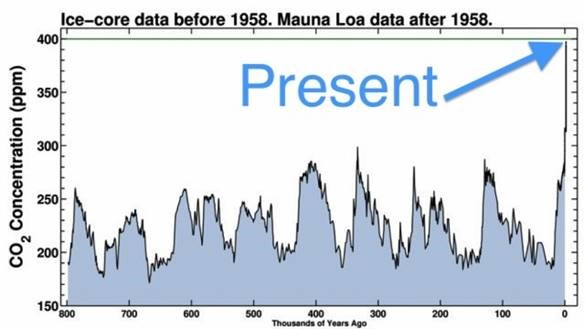Climate Illuminated

IPCC Claims CO2 Resides 1K Years

ED: CO2 residency from IPCC is 1000 years in residency for the major portion of the ACO2. Recent paper below says perhaps more like 4 years.
By P Gosselin on 26. March 2017
As usual, there are many highly interesting posts on climate science at the German Die kalte Sonne site.
What follows is one of the latest, on Harde’s controversial paper: ========================================
Is CO2 residence time in the atmosphere exaggerated?
By Dr. Sebastian Lüning and Prof. Fritz Vahrenholt (German text translated/edited by P Gosselin)
The CO2 content in the earth’s atmosphere has risen to a level that surpasses any level seen over the past 800,000 years (Fig. 1). While during the ice ages the CO2 concentration dropped to 180 ppm, it rose to 250 – 300 ppm during the warm periods (interglacials). The reason for this CO2 development is foremost is the gassing out of CO2 from warmed up interglacial water.
Since the start of the industrial revolution the CO2 concentration has reached well above the typical range seen during the previous interglacials. Currently the atmospheric CO2 concentration is a bit over 400 ppm.

Fig. 1: CO2-concentration over the past 80,000 years. Source: Scripps Institution of Oceanography, via Climate Central.
The big question now is how long will it take nature to bring down the anthropogenic CO2 build-up if CO2 emissions were to be massively cut back? Let’s assume that beginning today all coal, oil and gas were to be banned outright. How many years would it take for the CO2 to be absorbed by the natural cycles from the atmosphere?
The 5th IPCC report writes here that 60 – 85% of the anthropogenic CO2 would disappear from the atmosphere in about 1000 years. But the complete removal would take a few hundred thousands of years.
In Chapter 6 from Working Group 1:
The removal of human-emitted CO2 from the atmosphere by natural processes will take a few hundred thousand years (high confidence). Depending on the RCP scenario considered, about 15 to 40% of emitted CO2 will remain in the atmosphere longer than 1,000 years. This very long time required by sinks to remove anthropogenic CO2 makes climate change caused by elevated CO2 irreversible on human time scale.”
Other experts say 100 years
According to the German Ministry of Environment (UBA) things are, however, quicker. At the UBA website we find:
Carbon dioxide is a colorless and odorless gas whose average residence life in the atmosphere is 120 years.”
German climate scientist Mojib Latif also accepts a similar figure: Infranken.de reported on 13 January 2016 on a presentation made by Latif within the scope of a Lion’s Club event:
‘CO2 remains in the air 100 years’ Climate scientist Professor Mojib Latif as a guest speaker brought attention to climate change at the New Year’s meeting. […] ‘When we blow CO2 into the air, then it stays there for 100 years,’ said Latif.”
Hermann Harde of the Helmut Schmidt University in Hamburg described in a paper that appears in the May 2017 journal Global and Planetary Change and which is already available online presents a new approach that points to a much shorter residence time in the atmosphere. According to Harde, excess CO2 remains in the atmosphere on average only 4 years:
Scrutinizing the carbon cycle and CO2 residence time in the atmosphere Climate scientists presume that the carbon cycle has come out of balance due to the increasing anthropogenic emissions from fossil fuel combustion and land use change. This is made responsible for the rapidly increasing atmospheric CO2 concentrations over recent years, and it is estimated that the removal of the additional emissions from the atmosphere will take a few hundred thousand years. Since this goes along with an increasing greenhouse effect and a further global warming, a better understanding of the carbon cycle is of great importance for all future climate change predictions. We have critically scrutinized this cycle and present an alternative concept, for which the uptake of CO2 by natural sinks scales proportional with the CO2 concentration. In addition, we consider temperature dependent natural emission and absorption rates, by which the paleoclimatic CO2 variations and the actual CO2 growth rate can well be explained. The anthropogenic contribution to the actual CO2 concentration is found to be 4.3%, its fraction to the CO2 increase over the Industrial Era is 15% and the average residence time 4 years.”
This value is not to be confused with the residence time of single CO2 molecules in the atmosphere. Here there’s widespread agreement that the molecules themselves remain in the air only a few years before they get replaced by CO2 from the oceans in the sense of an equilibrium reaction.
We present a carbon cycle with an uptake proportional to the CO2 concentration. Temperature dependent natural emission and absorption rates are considered. The average residence time of CO2 in the atmosphere is found to be 4 years. Paleoclimatic CO2 variations and the actual CO2 growth rate are well reproduced. Human emissions only contribute 15 % to the CO2 increase over the Industrial Era.
Climate scientists presume that the carbon cycle has come out of balance due to the increasing anthropogenic emissions from fossil fuel combustion and land use change. This is made responsible for the rapidly increasing atmospheric CO2 concentrations over recent years, and it is estimated that the removal of the additional emissions from the atmosphere will take a few hundred thousand years. Since this goes along with an increasing greenhouse effect and a further global warming, a better understanding of the carbon cycle is of great importance for all future climate change predictions. We have critically scrutinized this cycle and present an alternative concept, for which the uptake of CO2 by natural sinks scales proportional with the CO2 concentration. In addition, we consider temperature dependent natural emission and absorption rates, by which the paleoclimatic CO2 variations and the actual CO2 growth rate can well be explained. The anthropogenic contribution to the actual CO2 concentration is found to be 4.3%, its fraction to the CO2 increase over the Industrial Era is 15% and the average residence time 4 years.
We should revisit occasionally what the proper role of government is. As the constitution was a good sense of direction, we need a core set of principles to add in order to deal with the future.
So many want to engineer society, remove risk, assist certain groups, rather than let individuals thrive and raise communities. Why?
Is Democracy where we all "get it good and hard" or is it the best means to a free society?
Should we roll with the special interests, or make the government achieve its proper role, what is that role, and how to do this?
When do deficits and governments become too large?
Government is becoming more elitist while trying to sell corrections to problems it created, what makes this possible?
This could also be inserted into the field above, or erased
Currently as a society, we are having a most difficult time discussing political issues. What is driving this? And why a rebirth in political culture would be a good thing.
Are "markets" dead as some would conjecture? Or is free enterprise what got us here?
At the heart of economics there are several possible economic schools of thought, the essence of these schools of thought and how they relate to our lives.